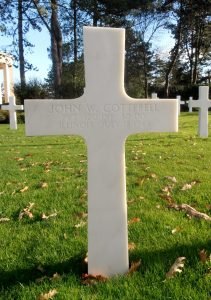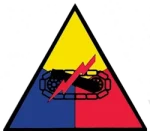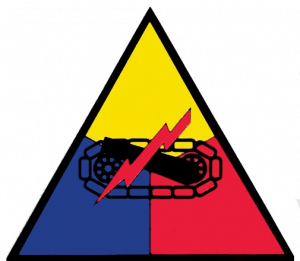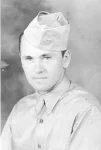Pvt. John Warren Cotterell was born on March 25, 1920, in Chicago, Illinois, to John A. Cotterell and Ophelia Paulson-Cotterell and was raised at 1443 South Fourteenth Avenue, Maywood, Illinois. He graduated from Garfield School and Proviso Township High School in 1938. After high school, he worked at the Harold M. Pitman Company, in Chicago, as a bookkeeper. On July 1, 1941, he registered with Selective Service and named his father as his contact person.
On August 14, 1941, John enlisted in the US Army in Chicago and given the serial number was 16 034 356. It is known that he trained at Fort Custer, Michigan, Ft. Jackson, South Carolina, and Camp Forrest, Tennessee. At some point, he was assigned to 120th Infantry Regiment, 30th Infantry Division. At Camp Atterbury, Indiana, in November 1943, the division prepared to go overseas. They then moved to Camp Myles Standish, Massachusetts, for final processing. From there, the unit moved to Boston and sailed on February 12, 1944, on the SS Argentina for England. The men disembarked the ship at Glourock near Glasgow, Scotland. By train, they traveled south and across England to the south coast to Bognor Begis, where the unit was headquartered.
The 120th remained at Bognor Begis until April 3, 1944, when it was moved north to an area near Woodland Park. Buckinghamshire. The 30th was ordered. two days after D-Day to Southampton. They then, from June 9th through 13th, were transported to France where they landed on Omaha Beach. Once off the beach, they saw the destruction from the fighting that had taken place a little over a week earlier. The 120th’s first units moved into the front-lines on June 13th. On the 15th, the combat units engaged the German Army for the fist time and pushed the Germans back two and a half miles. That night the 120th fought off a German counterattack in hand to hand fighting. For the next month the regiment fought its way north toward Belgium.
Elements of the 120th were in the area of Saint Lo, France, on July 18th when they came under fire. What little is known is that John was hit by shrapnel killing him. That same day, he was buried in the La Cambe Cemetery, La Cambe, France, in Plot N, Row 7, Grave 66. in a shelter half. His parents learned of John’s death on August 8, 1944, in a telegram from the War Department. A memorial service was held for him at the end of October 1944, at Holy Communion Episcopal Church in Maywood.
At some point, John’s remains were exhumed and identification was confirmed by his identification tags. His father was sent a letter, dated July 31, 1947, providing him with information on his options for John’s final burial. He was asked to fill-out and return an enclosed form indicating where he wanted John buried. The form was received by the Office of the Quartermaster General indicating that John A. Coterell wanted his son buried in an American Military Cemetery. On November 13, 1947, that John’s casket was moved from La Cambe, France, to the US Military Cemetery, St. Laurent, France. This was done as part of the American Graves Registration Service’s attempt to consolidate the dead to one location.
When St. Laurent was designated a US Military Cemetery, Pvt. John W. Cotterell’s casket was exhumed again and reburied on January 17. 1949, at the Normandy American Cemetery, Colleville-sur-Mer, France, in Plot G, Row 13, Grave 5, with full military honors. His father was sent the flag that covered John’s casket with a letter that he received on April 15, 1949.
Pvt. John W. Cotterell, ASN 16 034 356
Plot G, Row 13, Grave 5
Headstone: Cross
St. Laurent (France) U.S. Military Cemetery
Mr. John A. Cotterell
212 South 5th Avenue
Maywood, Illinois
Dear Mr. Cotterell:
This is to inform you that the remains of your beloved ones have been permanently interred, as the recorded above, side by side with comrades who also gave their lives for their country. Customary military funeral services were conducted over the grave at the time of burial.
After the Department of the Army has completed all final interments, the cemetery will be transferred, as authorized by the Congress, to the care and supervision of the American Battle Monuments Commission. The commission will have the responsibility for permanent construction and beautification of the cemetery, including erection of the permanent headstone. The headstone will be inscribe with the name exactly recorded above, the rank or rating where appropriate, organization, State, and date of death. Any inquiries relative to the type of headstone or the spelling of the name to be inscribed thereon, should be addressed to the American Battle Monuments Commission, Washington 25, D. C. Your letter should include the full name, rank, serial number, grave location, and name of the cemetery.
While interment and beautification activities are in progress, the cemetery will not be open to visitors. You may rest assured that this final interment was conducted with fitting dignity and solemnity and that the grave-site will be carefully and conscientiously maintained in perpetuity by the United States Government.
Sincerely yours,
(signed)
H. FELDMAN
Major General
The Quartermaster General








